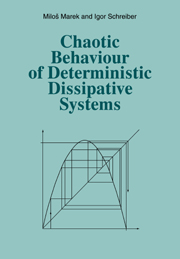Book contents
- Frontmatter
- Contents
- Preface
- 1 Introduction
- 2 Differential equations, maps and asymptotic behaviour
- 3 Transition from order to chaos
- 4 Numerical methods for studies of parametric dependences, bifurcations and chaos
- 5 Chaotic dynamics in experiments
- 6 Forced and coupled chemical oscillators – a case study of chaos
- 7 Chaos in distributed systems, perspectives
- Appendix A Normal forms and their bifurcation diagrams
- Appendix B CONT – a program for construction of solution and bifurcation dia-grams
- Index
5 - Chaotic dynamics in experiments
Published online by Cambridge University Press: 24 November 2009
- Frontmatter
- Contents
- Preface
- 1 Introduction
- 2 Differential equations, maps and asymptotic behaviour
- 3 Transition from order to chaos
- 4 Numerical methods for studies of parametric dependences, bifurcations and chaos
- 5 Chaotic dynamics in experiments
- 6 Forced and coupled chemical oscillators – a case study of chaos
- 7 Chaos in distributed systems, perspectives
- Appendix A Normal forms and their bifurcation diagrams
- Appendix B CONT – a program for construction of solution and bifurcation dia-grams
- Index
Summary
Introduction
Chaos has been observed in a large number of both natural and artificial nonlinear dissipative dynamical systems. For example, it has been shown in observations and computations of the evolution of meteorological patterns in the Earth's atmosphere that the patterns of evolution are very sensitive to initial conditions and predictions necessarily diverge after several days. These observations can be interpreted as an indication of the presence of a chaotic attractor in the corresponding state space. Also in the studies of populations dynamics it is often observed that the sizes of populations fluctuate widely from one season to the next; this can again be interpreted on the basis of the existence of chaotic trajectories in the population state space.
Recent developments in the theory of nonlinear dynamical systems coupled with the use of computers in the acquisition and analysis of long time series of experimental data have supported an exponential increase of detailed studies of various nonlinear dissipative systems displaying aperiodic behaviour and lead to both the confirmation of the presence and a detailed characterization of chaotic attractors.
Several model systems have been studied mostly with the aim of verifying theoretical predictions. Among them are classical hydrodynamical systems for the study of the development of turbulence – the Taylor–Couette flow and the Rayleigh–Bénard convection, nonlinear electronic oscillatory circuits, oscillatory mechanical systems, lasers, chemical systems (well stirred reactors) and various oscillating or excitatory structures in biology (heart cells, neurones).
Experimental observations on nonlinear circuits give results which are closest to theoretical predictions.
- Type
- Chapter
- Information
- Chaotic Behaviour of Deterministic Dissipative Systems , pp. 126 - 202Publisher: Cambridge University PressPrint publication year: 1991



